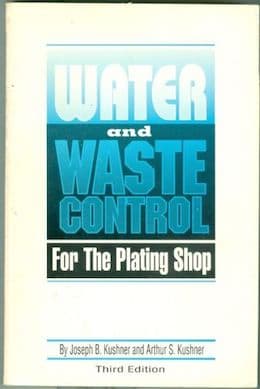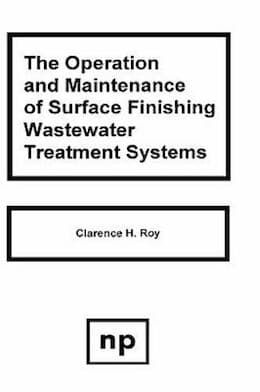
-----
Electrocoagulation for electroplating waste water
Q. I am investigating Electrocoagulation for wastewater treatment for an electroplating operation we are setting up in China. I am trying to arrive at zero discharge. We will be plating Copper, Watts Nickel, Hex Chrome, Zinc, Gold, Silver, Bronze.
I have heard about electrocoagulation. It sounds great, but to read topic 4924, "Electrocoagulation for wastewater treatment?" on the finishing.com site, this technology has been less than successful in the past.
Does anyone have any experience using this type of equipment? Just reading what is on commercial web sites, this sounds like the best thing since sliced bread.
Is it really?
-East Norristown, Pennsylvania
2001
by Kushner & Kushner

on eBay (rarely)
or Amazon (rarely)
(affil link)
A. EC has been successfully implemented on some waste streams, however as you mentioned, the feedback here isn't always so positive as the web sites might have you believe. On a simple metals basis, it can work effectively. However, put into the water various chelators, complexers, surfactants, brighteners, oxidizers, etc., and the whole mix changes quite rapidly. Unfortunately, this description fits about 85% of typical metal finishing plants -- hence the replies here vs. the marketing.
It is a good technology as long as
1) your influent NEVER changes, and
2) you have lots of patience and back-up storage capacity to re-treat if necessary, and you can troubleshoot it yourself.
It is not as reliable as conventional chemistry treatments because there are too many external radical reactions that can take place. In other words, it's not straight forward, and it doesn't lend itself to troubleshooting like conventional chemistry does. There is no "well, the pH was out of whack" or "the reducer feed pump might have been off a bit" - it works or it doesn't. Not much you can do to tell either until its out of the system - unlike other treatment approaches.
Like Clint Eastwood asks: Do ya feel lucky?

Tom Baker
wastewater treatment specialist - Warminster, Pennsylvania
2001
A. The latest generation of electrocoagulation is far superior to the electrocoagulation equipment of the past. I think that electrocoagulation has a bad reputation, because of the older attempts and lack of new marketing to get the word out that many of the older problems have been overcome. It will treat a wide variety of wastes, but the only way to know if it will work for you is to have the treatability study done at your plant.

Jon Barrows, MSF, EHSSC
Kansas City
2001
Q. There is a major problem in electrodes, i.e., passivation. I bought a plant with electrocoagulation process. But, due to severe passivation in the electrodes, my maintenance costs are being increased drastically. Electrodes contains aluminum and MS plate in bi-polar method. Please advise me how can I reduce cost in the process.
Regards,
- Chennai, India
November 14, 2011
Q. Dear Sir,
Cloud you please tell me the advantages & disadvantages of Electrocoagulation process for wastewater treatment plants over conventional processes?
Regards
Istiak
- Dhaka, Bangladesh
November 26, 2008
Q. We are going to install a new plating line Cr-Ni. We would like to recover the water to reuse in the plant. Is electrocoagulation a good process to accomplish this at a reasonable cost? Is there any reliable supplier of this systems? Comments of electrocoagulation vs. physical - chemical treatment are welcome!.
Regards,
- Aguascalientes, Mexico
by Clarence Roy

on eBay or Amazon
or AbeBooks
(affil link)
A. Hi Istiak and Ricardo. We've appended your inquiries to a thread which already partially answered them.
Istiak, if you can tell us what kind of waste, the volume, the discharge limitations, etc., people may be able to offer a more targeted response for you. Good luck.
Ricardo, re-use of the treated water from electroplating is a question largely not addressed by whether electrocoagulation is employed or not. Electroplating requires highly conductive plating baths, so the wastes contain large amounts of chlorides, sulphates, potassium, sodium and other highly soluble ions that are typically not removed during either typical chemical or electrocoagulation treatments, and will build up rapidly if the wastewater is recycled. Re-use usually requires careful study of how and how much of the wastewater can be fed back into the loop without causing an unacceptable buildup. Best of luck.
Regards,

Ted Mooney, P.E.
Striving to live Aloha
finishing.com - Pine Beach, New Jersey
Ted is available for instant help
or longer-term assistance.
A. We are in the process of designing and building a large water recycling system / zero discharge system for the exact same application right now for another plant outside of Leon! If you want to reuse the water, neither of these technologies are really amenable to what you want.
Electrocoagulation requires the formation of a counter-ion complex of iron with the metals in water. It works fine with very dilute concentrations of metals, but not too well with what you would see off a plating line under even normal circumstances. It would make heaps of sludge too. The worst part of it is that it will do nothing to remove any of the anions that you have in the water , so if you recycle the water from a EC machine, it will build up in salts very quickly, rendering the water aggressive and not at all amenable to the plating rinse process.
Physical chemical treatment will also do a nice job on the metals, even concentrated ones, but it requires the use of additional chemical to make it work, which adds to the salt concentrations exponentially. This eliminates the use of several good technologies for water recycling and narrows the field to essentially an Advanced Reverse Osmosis system - one that should be sized to operate on salt concentrations of 6,000 to 8,000 mg/L - not a small task. Since this is your only means of recycling, you need adequate storage and redundancy values in the plant for pumps, controls, separate operating trains, etc.

Tom Baker
wastewater treatment specialist - Warminster, Pennsylvania
A. Recycling of Nickel and Chromium Plating rinses is a common practice. However, the best way to do this is before a conventional treatment system. This saves you money and makes recovery possible. It is also best to keep the rinses segregated in order to return as much nickel and chromium to the plating tanks as possible.
Electrocoagulation does not remove dissolved salts from water, and therefore cannot produce water that is pure enough to be dragged into a nickel or a chromium bath or for final rinsing (it will leave spots and stains).
The best approach is usually to use one or two drag-out rinses after nickel plating that are used to replace evaporation from the plating tank, followed by two rinses that are recycled. Provided that the flowing rinse concentration is low, then deionization is the preferred technology for recycling the water.
For the chromium plating bath, an atmospheric evaporator may be the best choice (assuming this is a chromic acid bath and not a trivalent bath). If you have enough rinse tanks then it may be possible to operate this in a closed loop. If there are not enough rinses, then the final one or two rinses after the recovery rinses can be recycled by the same DI system used to recycle the nickel rinse water. The DI water will result in a spot-free plated finish, and meet the requirements of automotive industry specifications for final rinse.
DI water should be used for make-up to avoid impurity buildups in the plating baths
consultant - Cleveland Heights, Ohio
Q. Can we do electrocoagulation in waste water treatment of Ni-Cr plating stream commonly or separately?
Rajesh Bassi- Ludhiana, Punjab, India
December 5, 2013
A. Hi cousin Rajesh. We found a previous thread on this subject and appended your inquiry to it. I think you'll find that your question is thus already answered. Good luck.
Regards,

Ted Mooney, P.E.
Striving to live Aloha
finishing.com - Pine Beach, New Jersey
Ted is available for instant help
or longer-term assistance.
Q, A, or Comment on THIS thread -or- Start a NEW Thread